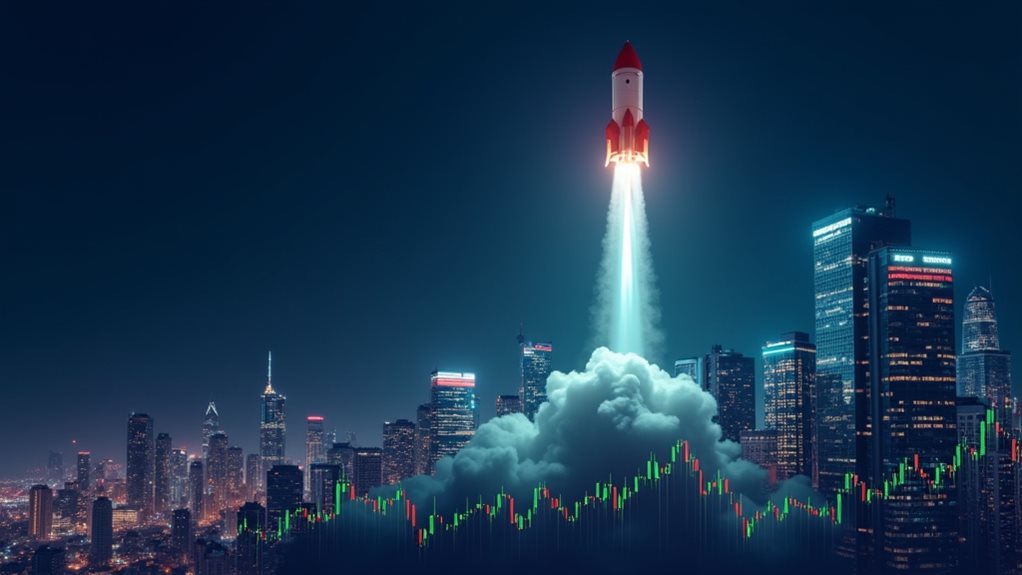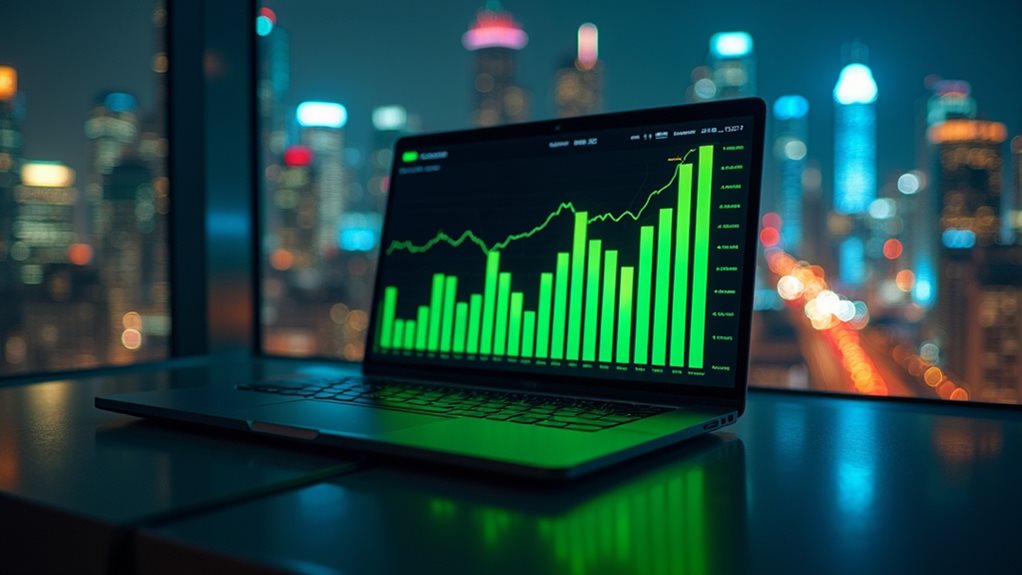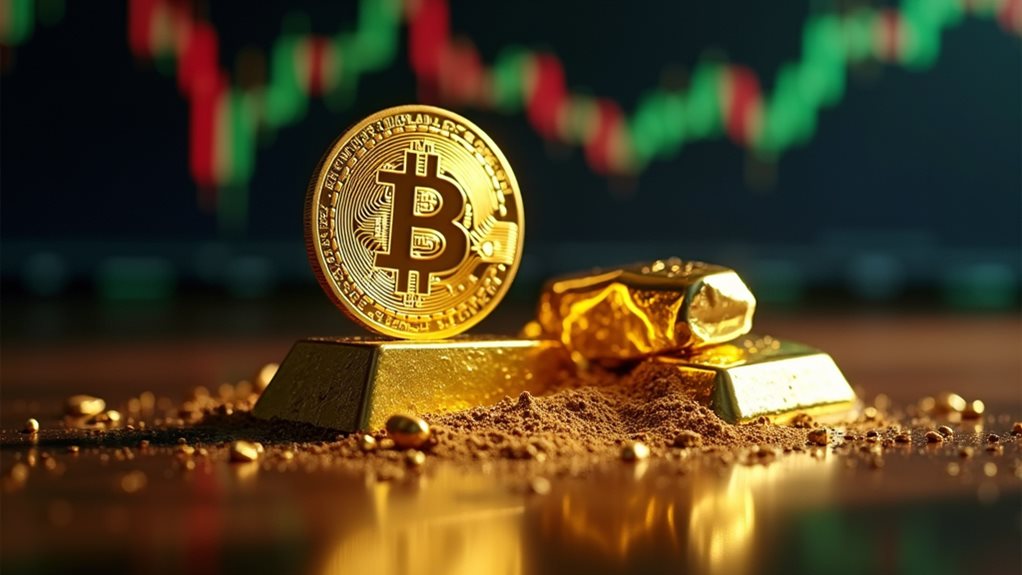Bitcoin's price movements during halvings have been dramatic, to say the least. The 2012 halving saw prices climb from $10 to $13, while 2016's event triggered a delayed surge that peaked around July 2017. The 2020 halving? That's when things got really wild – Bitcoin skyrocketed to $60,000 by March 2021. Each halving has shown increasingly volatile price swings, though patterns aren't guarantees. There's more to these crypto rollercoasters than meets the eye.

While cryptocurrency markets are known for their wild price swings, Bitcoin halvings represent some of the most significant catalysts for dramatic price movements. Like clockwork every four years, these halvings slash the rate of new Bitcoin production in half. The results? Pretty mind-blowing, actually.
Let's look at what happened in 2012. Bitcoin was just a baby then, trading around $10.26 when the first halving hit on November 28. The block reward dropped from 50 to 25 BTC, and the price jumped to $13.42 shortly after. Not exactly earth-shattering at first glance, but wait for it – this was just the beginning. The network's peer-to-peer technology enabled these transactions to occur without any central authority.
The 2016 halving proved more interesting. When the reward dropped from 25 to 12.5 BTC on July 9, the market did something funny. The price initially dipped, making some investors nervous. But then? Bitcoin went absolutely bonkers. By July 2017, prices had skyrocketed. Talk about a delayed reaction.
Then came 2020's halving spectacle. On May 11, the reward dropped again, this time from 12.5 to 6.25 BTC. What followed was nothing short of historic. By March 2021, Bitcoin had surged to around $60,000. That's the kind of return that makes traditional investors' heads spin. These events are closely watched by investors who track every development in the cryptocurrency space.
These price movements aren't just random luck. Each halving fundamentally changes Bitcoin's supply dynamics. When new Bitcoin production slows down but demand stays steady or increases, something's got to give. Usually, it's the price – upward. With predictions for the 2024-2028 cycle ranging from price targets of $80,000 to $250,000, investors remain optimistic about Bitcoin's future value. Recent analyst projections suggest Bitcoin could reach Q4 2025 targets of $185,000 as institutional adoption accelerates.
Bitcoin halvings create a powerful supply squeeze – when production drops but demand holds, prices have nowhere to go but up.
But it's not all sunshine and rainbows for everyone involved. Miners feel the pinch during these events. Their rewards get cut in half, forcing them to rely more on transaction fees. Some miners can't handle the heat and drop out, temporarily reducing the network's overall hashrate. But here's the thing – the network adapts. It always does.
Market sentiment plays a huge role too. Investors start getting antsy months before each halving. Media attention ramps up. Speculation runs wild. It's like clockwork – the crypto community buzzes with anticipation, driving both volatility and interest through the roof.
Despite these historical patterns, nobody can predict exactly what will happen during the next halving in 2024. Past performance doesn't guarantee future results – that's just how markets work.
But one thing's for sure: these halvings have consistently preceded some of Bitcoin's most dramatic price movements.
Frequently Asked Questions
What Happens to Bitcoin Mining Rewards After Each Halving Event?
Bitcoin mining rewards get slashed in half – it's that simple.
The first halving dropped rewards from 50 BTC to 25 BTC per block. Then came the second cut to 12.5 BTC in 2016.
By 2020, miners were getting just 6.25 BTC. Now in 2024, they're down to 3.125 BTC.
This pattern keeps going until all 21 million bitcoins are mined. Smaller miners often get squeezed out, while bigger operations adapt or die.
How Do Cryptocurrency Exchanges Prepare for Bitcoin Halving Events?
Cryptocurrency exchanges go into full prep mode before Bitcoin halvings.
Security gets beefed up, trading systems are stress-tested for volume spikes, and customer support teams expand.
Let's face it – halvings are like crypto's Super Bowl.
Exchanges load up on educational content to keep users informed and roll out extra market analysis tools.
They've learned from past events that halvings mean intense trading activity.
No exchange wants their system crashing during the big show.
Can Regular Investors Profit From Bitcoin Halving Cycles?
Regular investors can capitalize on Bitcoin halving cycles by understanding historical patterns.
Past halvings show a trend of price increases in the following months – though nothing's guaranteed. The reduced supply typically drives up demand.
Smart money watches these four-year cycles closely. Some investors buy before halvings and hold through the volatility.
But timing the market? That's another story. Profit potential exists, but so do risks.
Why Does Bitcoin Have Scheduled Halving Events Built Into Its Code?
Bitcoin's halving events serve as a built-in inflation control mechanism. Plain and simple.
Satoshi Nakamoto, Bitcoin's mysterious creator, programmed these halvings to gradually reduce the supply of new bitcoins until reaching the maximum cap of 21 million. It's genius, really.
By slashing mining rewards every four years, the system creates artificial scarcity. No central bank needed – just pure code doing its thing.
Think of it as digital population control for crypto.
How Do Bitcoin Miners Stay Profitable Despite Reduced Rewards After Halving?
Bitcoin miners adapt to survive – it's that simple.
They upgrade to more efficient mining equipment, slash operational costs, and hunt for cheap electricity sources. Some focus on processing higher-fee transactions.
The big players? They scale up operations for better economies of scale. Smaller miners often get squeezed out – tough luck.
Many also diversify into new revenue streams like Ordinals. When block rewards drop, transaction fees become their bread and butter.









